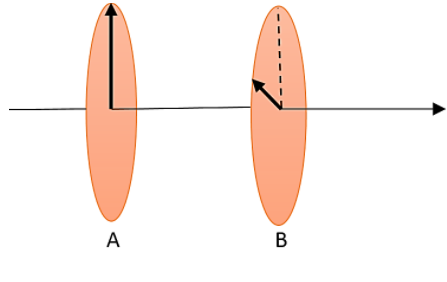
Two Polaroids A and B are placed with their Polaroid axes


Answer
493.2k+ views
Hint: The intensity
Formula used:
Where
Complete answer:
As we already said, the malus law states that, the intensity
This can be written in the form of an equation,
As already mentioned in the question, the angle between the transmission axes and the Polaroid is given as
Let us substitute this in the equation of malus law,
As we all know the value of cosine of
Taking the square of this,
Substituting this in the equation will give,
This has been given as the option A.
Therefore the correct answer is option A.
Note:
When light is incident on a polariser, the transmitted light will get polarised. This polarised beam of light falls on another Polaroid which will transmit light according to the orientation of its axis with the polariser. This is known as analyser. The intensity of light when the light passes through an analyser is given by the Malus law.
Formula used:
Where
Complete answer:
As we already said, the malus law states that, the intensity
This can be written in the form of an equation,
As already mentioned in the question, the angle between the transmission axes and the Polaroid is given as
Let us substitute this in the equation of malus law,
As we all know the value of cosine of
Taking the square of this,
Substituting this in the equation will give,
This has been given as the option A.
Therefore the correct answer is option A.
Note:
When light is incident on a polariser, the transmitted light will get polarised. This polarised beam of light falls on another Polaroid which will transmit light according to the orientation of its axis with the polariser. This is known as analyser. The intensity of light when the light passes through an analyser is given by the Malus law.
Recently Updated Pages
Master Class 9 General Knowledge: Engaging Questions & Answers for Success

Master Class 9 English: Engaging Questions & Answers for Success

Master Class 9 Science: Engaging Questions & Answers for Success

Master Class 9 Social Science: Engaging Questions & Answers for Success

Master Class 9 Maths: Engaging Questions & Answers for Success

Class 9 Question and Answer - Your Ultimate Solutions Guide

Trending doubts
Give 10 examples of unisexual and bisexual flowers

Draw a labelled sketch of the human eye class 12 physics CBSE

Differentiate between homogeneous and heterogeneous class 12 chemistry CBSE

Differentiate between insitu conservation and exsitu class 12 biology CBSE

What are the major means of transport Explain each class 12 social science CBSE

Why is the cell called the structural and functional class 12 biology CBSE




